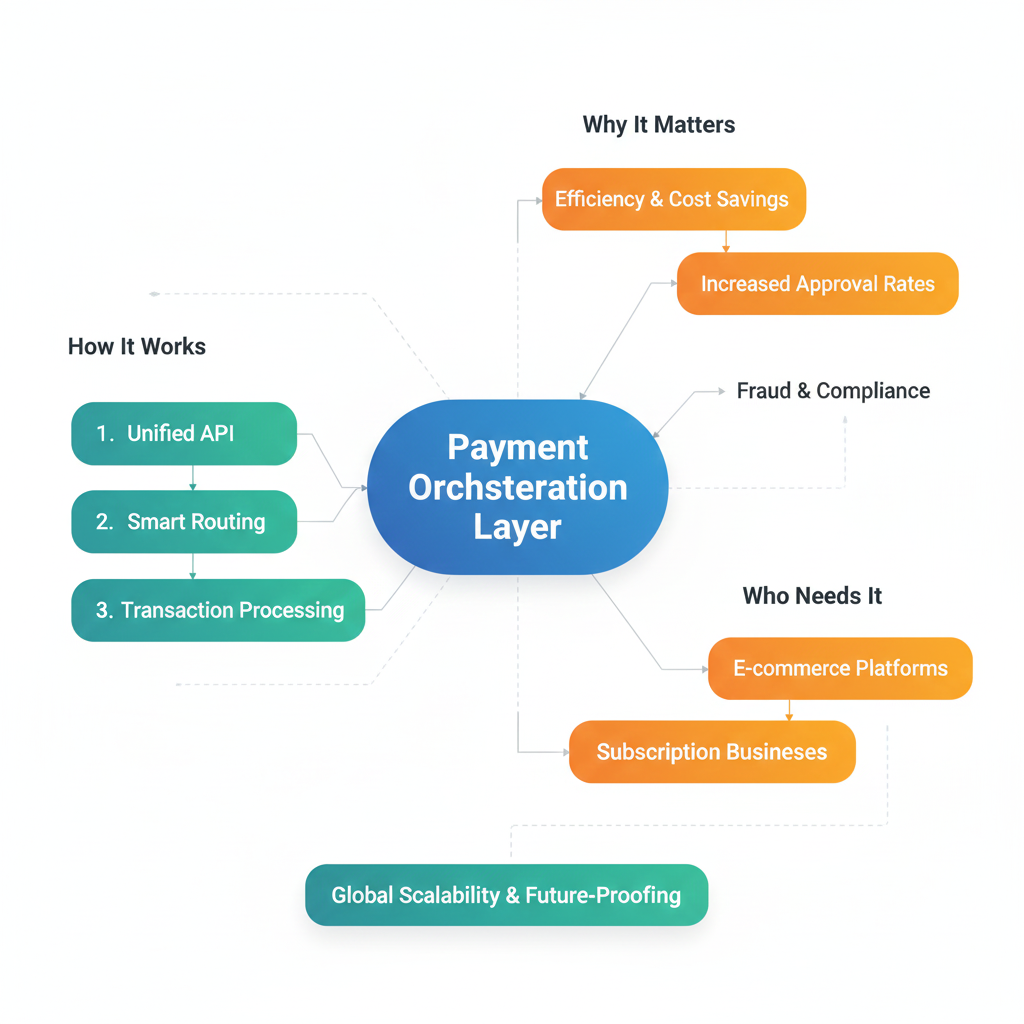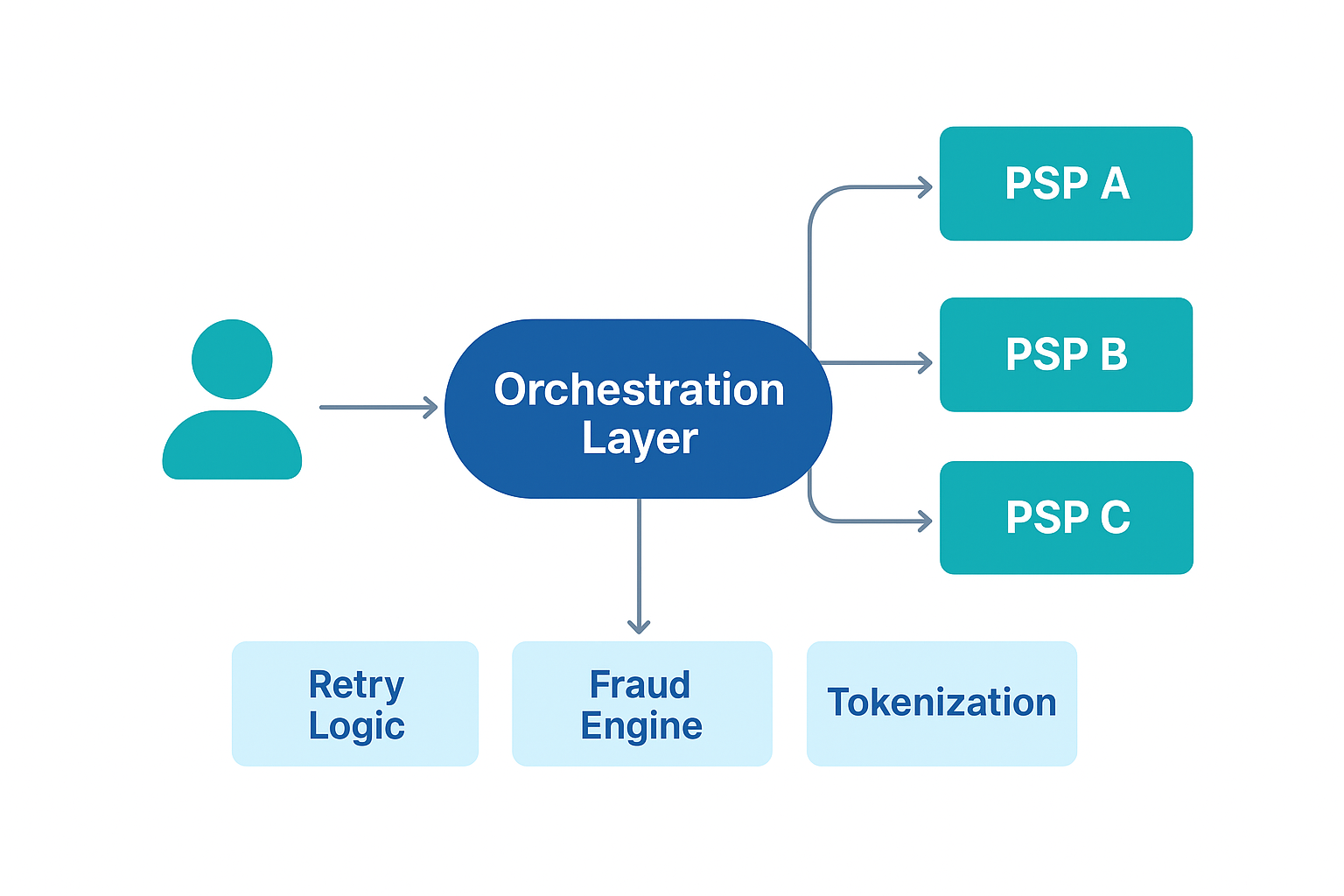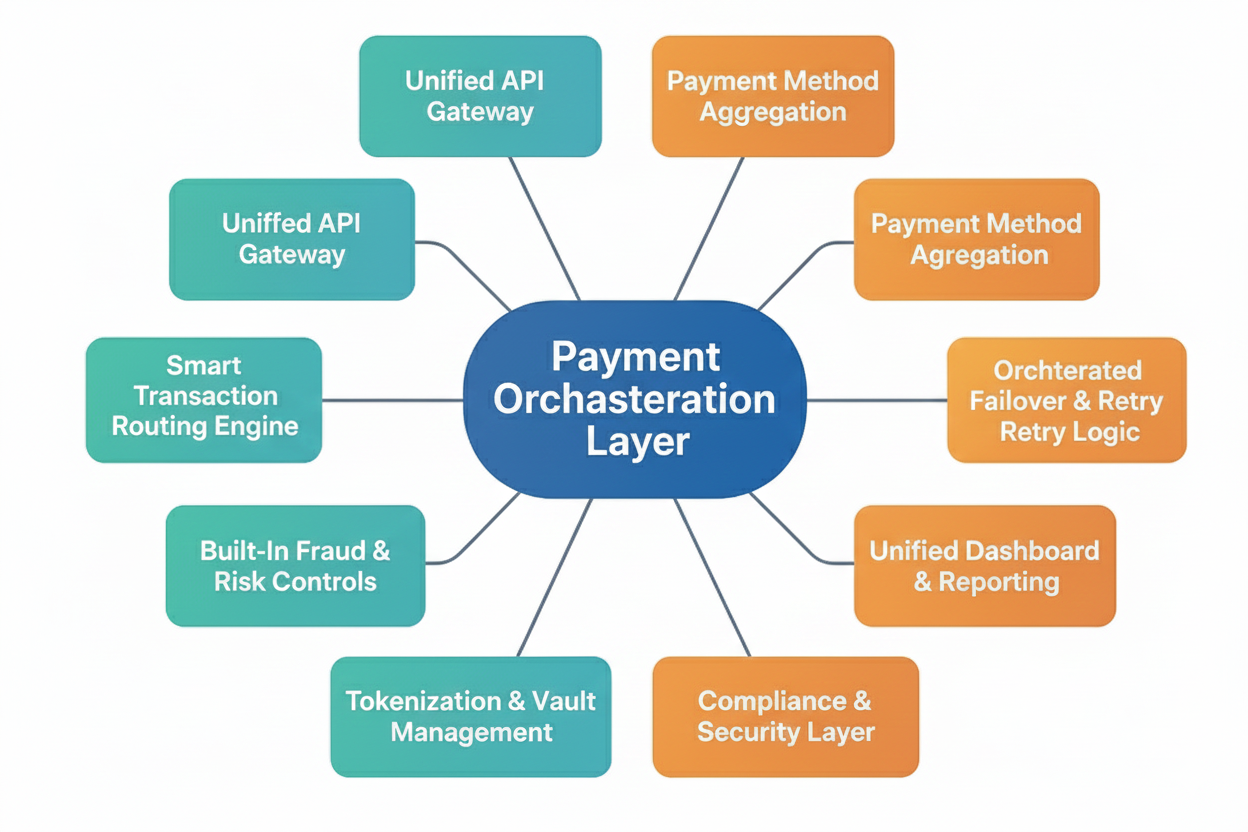Payment Orchestration Layer Explained: How It Works, Why It Matters & Who Needs It
November 21, 2025
Author:
Garry


A payment orchestration layer is basically the control center of your entire payment flow. If you’re selling online, you already know how messy payments can get when you depend on just one gateway. Sometimes it approves transactions smoothly, other times it fails for no reason. An orchestration layer sits between your website/app and all your payment providers and quietly decides which processor should handle each transaction so your customer doesn’t experience friction. You don’t have to manually switch gateways or keep checking which one is performing better on a given day; the system does that work for you automatically.

At PayFirmly, we deal with merchants in e-commerce, gaming, crypto, subscriptions, adult, Cannabis & CBD, and other high-risk industries every single day. The problems they face are always the same: random declines from a single PSP, delayed settlements, region-based blocks, and a constant struggle to remain compliant. When you’re operating in such environments, one “bad” gateway can easily affect your revenue. This is exactly why payment orchestration exists to bring everything together, remove the dependency on any one provider, and give you complete control over how your payments move across your system.
In this blog, I’ll walk you through how the orchestration layer actually works behind the scenes, why it has become so important, and how companies use it to build a stable, scalable payment system for the future.
How a Payment Orchestration Layer Works? (Simple Technical Breakdown)
A payment orchestration layer works like a smart control center that manages your entire payment flow from start to finish. When a customer tries to pay, the layer doesn’t just forward the transaction to one gateway it evaluates the user’s region, currency, risk score, device, past behavior, and the historical performance of each payment provider. Then it routes the payment to the most reliable and cost-effective processor in real time.

Behind the scenes, the orchestration layer performs multiple functions in milliseconds: tokenizing card data, applying fraud checks, running 3D Secure when needed, selecting the best PSP, retrying failed payments intelligently, and sending the final response back to your checkout system. All of this happens without the customer realizing anything has changed.
At PayFirmly, we see that merchants who depend on a single gateway often lose 10–20% of revenue to avoidable declines, regional blocks, or slow acquirers. With orchestration, every transaction gets the optimal path, which directly boosts approvals and stabilizes cash flow. This is why modern, high-volume businesses use orchestration as the foundation for reliable global payments.
Core Components Inside an Orchestration Layer
A payment orchestration layer isn’t just a “router” it is a full ecosystem of tools that sit between your checkout and multiple processors. Each component plays a strategic role in improving approval rates, reducing payment costs, and maintaining compliance across regions.
Below are the core building blocks that make an orchestration layer work:

1. Unified API Gateway
This is the single integration point for your entire payment system. Instead of building separate connections with each PSP, your developers integrate once with the orchestration layer. Every payment method, every acquirer, and every settlement path flows through that one API.
2. Smart Transaction Routing Engine
This is the heart of orchestration. It decides which processor should handle the transaction based on real-time performance, location, BIN ranges, cost, and risk indicators. If one gateway is down or performing poorly, routing automatically shifts to another no downtime for your business.
3. Built-In Fraud & Risk Controls
The orchestration layer includes 3D Secure handling, device fingerprinting, velocity checks, IP analysis, and AI-based fraud scoring. These layers work together to stop bad transactions without hurting conversion.
4. Tokenization & Vault Management
Customer card data is safely converted into tokens, allowing recurring billing, 1-click payments, and subscription renewals without PCI burden on your infrastructure.
5. Payment Method Aggregation
Merchants can instantly access local and global payment methods (cards, APMs, wallets, bank transfers, crypto, etc.) without individually negotiating or integrating each provider.
6. Orchestrated Failover & Retry Logic
If a transaction fails due to technical error, processor downtime, or soft decline, the system automatically retries the payment through alternative acquirers using smart logic. This single feature can recover thousands in monthly lost revenue.
7. Unified Dashboard & Reporting
All transactions, all providers, all settlements appear in a consolidated dashboard. This helps your team understand what’s working, where declines are happening, and how payment costs can be optimized.
8. Compliance & Security Layer
PCI DSS Level 1, PSD2, GDPR, AML/KYC hooks, chargeback handling everything is centralized so merchants can meet regional regulations without building custom compliance workflows.
Types of Payment Orchestration Layers (Full Overview)
Not every payment orchestration layer works the same way. Different businesses need different levels of control, compliance, and routing flexibility. Based on how the technology is built and deployed, orchestration layers are generally divided into three major types.

1. Front-End Orchestration Layer (Checkout-Level Orchestration)
This type focuses on improving customer experience at the checkout stage. It governs what payment options appear, how they are displayed, and how fallback methods are triggered if a gateway is unavailable.
2. Back-End Orchestration Layer (Processor Routing + Compliance)
This is the most powerful version. It handles everything behind the scenes — routing transactions, managing multiple PSPs, fraud checks, tokenization, retries, and settlements.
This is the model PayFirmly specializes in, where the entire payment flow is automated, regulated, and optimized without requiring merchants to rebuild their infrastructure.
3. Full-Stack Payment Orchestration (Front + Back Combined)
This is a complete orchestration ecosystem that controls both the checkout interface and the backend routing engine. It acts as a full payment infrastructure platform, allowing businesses to operate globally with minimal development effort.
4. In-House Orchestration (Custom-Built by Large Enterprises)
Some very large companies attempt to build orchestration internally. They create their own routing logic, connect multiple processors manually, and manage compliance themselves. However, this usually becomes costly, slow to maintain, and difficult to keep compliant with PCI/PSD2/AML regulations.
5. Hybrid Orchestration Layer
This is when a merchant combines its existing payment setup with an orchestration provider. For example, they may use one in-house processor + PayFirmly for global routing, compliance, local APMs, crypto payments, or backup coverage.
Why Payment Orchestration Matters for Modern Businesses
The payment ecosystem has changed dramatically over the last few years. Customers now pay through cards, wallets, BNPL, bank transfers, crypto, local APMs, and region-specific payment methods. At the same time, regulations, fraud patterns, and gateway performance vary every day. A single payment gateway simply cannot keep up with this complexity and that’s where payment orchestration becomes essential.
Modern businesses rely on orchestration because it gives them control, flexibility, and stability across all payment operations. Instead of being tied to one processor, the orchestration layer automatically selects the best-performing PSP for every transaction. This means fewer declines, lower fees, and a faster checkout experience for customers.
For high-risk and high-growth merchants, payment orchestration is not just important it’s a competitive advantage. Industries like crypto, gaming, subscription platforms, adult, CBD, and global marketplaces face stricter regulations and higher decline rates. Without orchestration, they risk losing up to 20–40% of revenue to avoidable payment failures.
Who Needs a Payment Orchestration Layer the Most?
While every online business can benefit from a smarter payment setup, certain industries depend on orchestration because traditional gateways simply can’t keep up with their transaction complexity. These merchants deal with regional restrictions, higher decline rates, strict compliance rules, and unpredictable processor behavior making orchestration not just helpful but necessary.
1. High-Risk Industries (Adult, CBD, Gambling, Gaming, VPN, etc.)
These sectors face elevated scrutiny, frequent gateway shutdowns, and constantly shifting compliance requirements. Without orchestration, they rely on a single PSP that may restrict or freeze accounts without warning. Orchestration gives them backup processors, smart routing, strong fraud controls, and regulatory coverage.
2. Global eCommerce & Cross-Border Businesses
Brands selling internationally must handle multiple currencies, local payment methods, and region-specific acquiring. Using one gateway limits reach. An orchestration layer ensures localized processing that improves conversion and customer experience.
For a deeper look at region-specific options, explore our guide to the top payment gateways in Europe.
3. Subscription & Membership Platforms
Recurring billing is sensitive; one gateway outage can disrupt thousands of renewals. Smart retry logic, tokenization, and processor fallback help recover failed subscriptions automatically.
4. Marketplaces & Platforms with Heavy Transaction Volume
Multi-vendor ecosystems need a stable foundation where payments, settlements, remittances, and compliance all work together. Orchestration makes it possible to manage all flows under one unified system.
5. Crypto Exchanges & Web3 Businesses
Crypto merchants need compliant fiat on/off-ramps, identity checks, and global processors that can support their operating model. Orchestration ensures safe, regulated, multi-provider payment flows for these businesses.
6. SaaS Platforms Offering Payments as a Feature
Companies offering invoicing, checkout tools, or embedded finance features use orchestration to aggregate multiple PSPs through a single API giving their customers access to many processors without extra integrations.
7. Enterprises Operating in Multiple Geographies
Large organizations require stability, redundancy, and compliance automation. Orchestration gives them predictable performance even at global scale.
Orchestration Layer vs Traditional Payment Gateway
Most merchants assume a payment gateway is enough—until they start scaling and run into decline spikes, downtime, compliance blocks, or regional restrictions. A traditional gateway is built to process payments. A payment orchestration layer is built to manage, optimize, and control the entire payment ecosystem.
Here’s the fundamental difference:
1. Single Provider vs Multi-Provider Flexibility
A traditional gateway gives you one route. If that PSP faces downtime, risk blocks, or regional issues, your payments fail.
An orchestration layer connects you to multiple acquirers and automatically shifts traffic to the best-performing one in real time.
2. Limited Tools vs Full Payment Infrastructure
Gateways usually offer basic processing—nothing more.
Orchestration layers include routing engines, tokenization, retries, fraud checks, vaults, dashboards, and compliance in one system.
3. Declines Are Dead Ends vs Intelligent Recovery
With a gateway, a failed transaction is simply a lost sale.
With orchestration, the system retries the payment through alternate processors, recovering revenue that would otherwise be lost.
4. Locked-In Setup vs Complete Flexibility
Gateways force merchants into rigid structures and long contracts.
Orchestration provides the freedom to add, remove, or switch processors with zero redevelopment.
5. Limited Visibility vs Centralized Reporting
Traditional gateways give you partial reports across multiple dashboards.
Orchestration combines all transactions, settlements, disputes, and processor data into one unified view.
6. Basic Fraud Filters vs Advanced, Multi-Layered Protection
Gateways often provide generic fraud tools.
Orchestration layers integrate device fingerprinting, 3DS orchestration, velocity checks, and AI-powered fraud scoring improving approval rates without increasing risk.
Real Business Impact Higher Approvals, Lower Fees & Smarter Routing
A payment orchestration layer creates a direct, measurable impact on revenue because it removes dependency on a single gateway. When every transaction is routed through the best-performing processor based on region, BIN range, currency, and real-time behavior, approval rates rise naturally. Many merchants who switch from a single-PSP setup to orchestration see an immediate 10–20% increase in successful transactions simply because fewer payments get stuck behind slow or underperforming processors.
Cost reduction is another major benefit. Each processor charges different fees depending on card type, region, and risk profile. With orchestration, the system automatically chooses the most cost-efficient option without affecting performance. This helps businesses reduce acquiring and processing costs by as much as 30% while also improving cash-flow predictability through unified settlements and consolidated reporting. Instead of chasing multiple dashboards, the entire payment picture becomes visible in one place.
The reliability gained from intelligent routing, smarter fraud control, and automated retries is just as important. Outages, temporary PSP blocks, and soft declines no longer result in lost sales because the orchestration layer instantly shifts traffic or retries payments in a structured way. At PayFirmly, we often see merchants recover 30–40% of previously failed transactions because the system turns every decline into an opportunity for recovery. This combination of higher approvals, lower costs, and stability is what makes orchestration a core growth engine for modern merchants.
How PayFirmly Helps You Build a Future-Ready Orchestration Setup
PayFirmly was created for contemporary vendors who require dependability, worldwide accessibility, intelligent routing, and legality all wrapped up in the tangle-free manual juggling of several payment providers. Our orchestration layer consolidates all PSPs, APMs, processors, and fraud tools into one unified system, which enables your business to function with transparency and assurance. Getting a fully orchestrated environment through one clean API—a single point of payment integration that is built to scale for global payments—means you won't have to waste time connecting to each gateway one by one.
Performance and revenue recovery are our main concerns too. With PayFirmly’s smart routing engine, each and every transaction is analyzed in real time according to its location, card issuer, BIN range, cost, and gateway success rate. In case a PSP is experiencing slow response times or instability, the traffic is immediately transferred to another one, thus guaranteeing higher approval rates and fewer complaints from customers. The whole process, together with automated retries, smart fraud controls, and tokenization, makes your payment flow much more predictable and profitable.
What makes PayFirmly different is our experience working with high-risk and high-growth businesses. Industries like adult, crypto, gaming, CBD, and global eCommerce often struggle with compliance blocks, gateway restrictions, and inconsistent settlements. Our platform solves these problems by offering a compliant, AI-driven, multi-processor ecosystem built to support even the most regulated environments. Whether you want to scale internationally, reduce fees, boost approvals, or build a resilient payment infrastructure, PayFirmly becomes your payment backbone — strong, secure, and ready for the future.
Secure Crypto Payment Orchestration & Processor with PayFirmly
The future of adult payment processing is intelligent, compliant, and built around you.
Join leading adult brands using PayFirmly to boost approvals, cut fees, and simplify multi-processor management — all from one secure dashboard.






